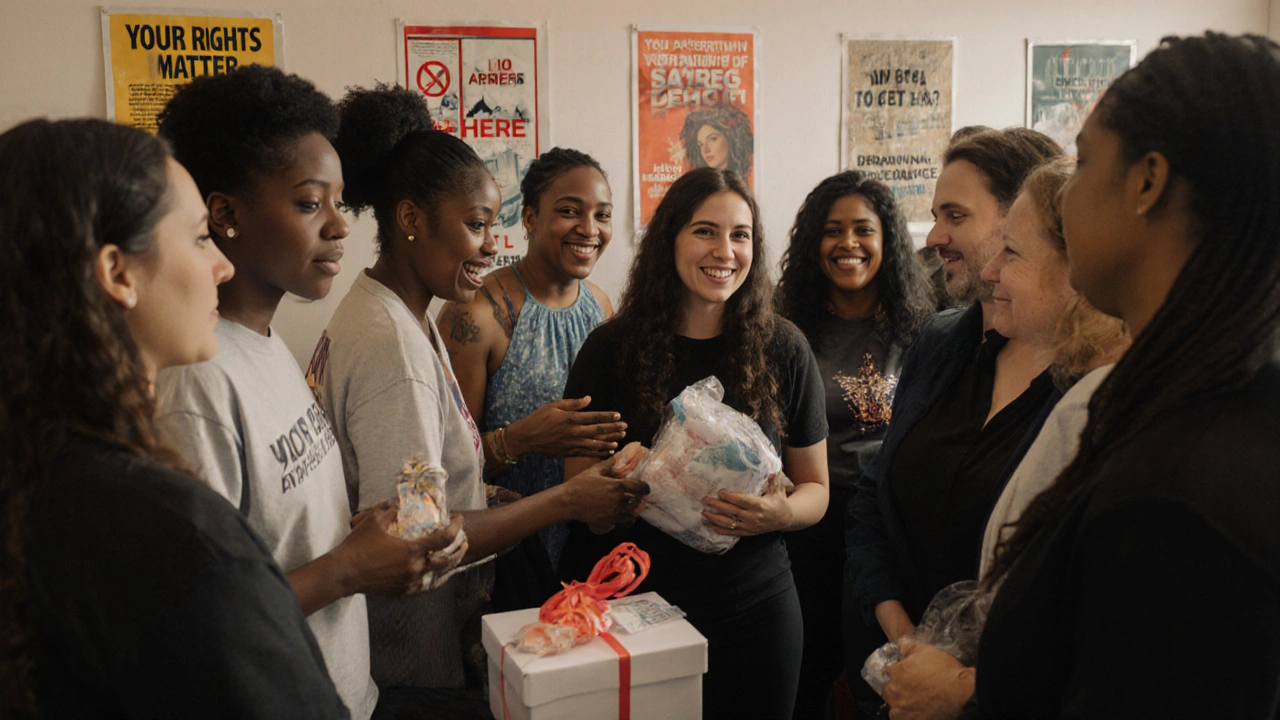Every year, thousands of people are arrested under laws meant to stop human trafficking-but many of them are sex workers doing consensual work. The confusion between sex work and human trafficking isn’t just a legal mistake; it’s a human rights issue. In places like Australia, the U.S., and parts of Europe, laws that claim to protect people often end up putting sex workers at greater risk. Understanding the real difference between voluntary sex work and forced trafficking isn’t about excusing exploitation-it’s about making sure the law actually helps the people it’s supposed to protect.
What Counts as Sex Work?
Sex work is the exchange of sexual services for money or goods between consenting adults. It includes street-based work, indoor work in apartments or brothels, online escorting, phone sex, and cam modeling. In Australia, sex work is legal in most states, including Western Australia where it’s regulated under health and safety standards. Workers can register their business, access labor rights, and report violence without fear of arrest.
The key here is consent. A person who chooses to sell sex, even under difficult economic conditions, is not automatically a victim. Studies from the University of Melbourne show that 87% of sex workers in Australia report they entered the industry voluntarily, and 73% say they feel in control of their working conditions. That’s not to say the work is easy or safe for everyone-but it’s not the same as being forced.
What Defines Human Trafficking?
Human trafficking involves coercion, deception, or force to make someone perform labor or sexual acts against their will. It’s not about money changing hands-it’s about control. Traffickers use threats, debt bondage, passport confiscation, physical violence, or psychological manipulation to trap people. The United Nations defines trafficking as a crime against the person, not a crime of commerce.
In Australia, trafficking cases are rare but serious. Between 2020 and 2024, the Australian Federal Police recorded 147 confirmed trafficking cases involving sexual exploitation. Of those, fewer than 10% involved Australian citizens. Most victims were foreign nationals brought in on temporary visas and then trapped by threats or debt. Unlike sex workers, these victims rarely have access to phones, bank accounts, or freedom of movement.
Where the Laws Get Mixed Up
The biggest problem isn’t that laws are too weak-it’s that they’re too broad. Many countries use the same laws to punish both traffickers and consensual sex workers. In the U.S., for example, laws like the Fight Online Sex Trafficking Act (FOSTA) shut down websites where sex workers advertised safely. That forced people back onto the streets, where they’re more vulnerable to violence.
In Australia, the law says you can’t pay for sex if the worker is under 18 or if you know they’re being exploited. But in practice, police sometimes use the threat of trafficking charges to pressure sex workers into testifying against others-even when there’s no evidence of coercion. A 2023 report from the Australian Human Rights Commission found that 42% of sex workers had been questioned by police under the guise of trafficking investigations, even though no trafficking was involved.
This blurring of lines has real consequences. When police treat all sex work as potential trafficking, workers stop reporting abuse. They stop seeking medical help. They stop using condoms. They stop talking to outreach workers. The law, meant to protect, ends up silencing the very people it should help.

Decriminalization vs. Legalization: What’s the Difference?
Not all sex work laws are the same. There’s a big difference between decriminalization and legalization-and it matters a lot.
Decriminalization means removing criminal penalties for sex work entirely. No laws say it’s illegal. Workers can operate without fear of arrest, and they can report crimes to police like any other worker. New Zealand fully decriminalized sex work in 2003. Since then, violence against sex workers dropped by 40%, and 89% of workers said they felt safer working with clients.
Legalization means the government allows sex work but only under strict rules. You need a license. You can only work in certain places. You can’t work alone. Sweden, Norway, and Iceland use a version of this called the Nordic Model, where selling sex isn’t illegal-but buying it is. The idea is to punish clients and pimps while “protecting” workers. But studies from the Karolinska Institute show that under this model, sex workers report higher rates of violence and less access to health services. Many go underground to avoid police attention.
Decriminalization gives workers power. Legalization gives the state control. The difference isn’t just legal-it’s life or death.
Why Criminalizing Clients Doesn’t Work
The Nordic Model sounds good on paper: stop demand, stop exploitation. But in practice, it pushes sex work further into the shadows. When clients can’t advertise online or meet in public spaces, they demand secrecy. Workers are pressured to go to isolated locations. They’re forced to accept riskier clients just to make rent.
A 2022 study in Norway tracked 120 sex workers before and after the client ban took effect. Within two years, 68% reported being assaulted more often. 54% said they had to work longer hours just to earn the same income. And 71% said they no longer trusted police, because officers treated them like criminals, not victims.
When you make it harder for people to screen clients, you make it easier for traffickers to operate. Traffickers don’t care about laws-they care about control. And they thrive where workers are isolated, scared, and invisible.
What Real Protection Looks Like
Real protection doesn’t come from arrests. It comes from rights.
In New Zealand, sex workers can unionize. They can file workplace complaints. They can access free STI testing and mental health services through government clinics. In Victoria, Australia, sex workers can get business licenses and open bank accounts without fear of being reported.
When you treat sex work like any other job, you give workers the tools to protect themselves. They can say no to unsafe clients. They can report threats without being arrested. They can demand safer working conditions. They can leave if they want to.
And here’s the most important part: when sex workers are safe, traffickers are easier to find. Because the real traffickers don’t blend in-they stand out. They isolate people. They control their documents. They use violence. When consensual workers are visible and protected, those patterns become obvious.

Where the Law Needs to Change
Current laws in many places are built on fear, not evidence. They assume all sex work is exploitation. But evidence shows that’s not true.
Here’s what needs to change:
- Remove criminal penalties for selling sex. No fines. No arrests. No registration fees that trap people in debt.
- Stop using trafficking laws to target consensual workers. Police need training to spot real trafficking-signs like missing passports, physical restraints, or threats of harm to family members.
- Expand access to services. Health care, legal aid, housing, and financial services should be available without judgment.
- Let workers organize. Unions, peer networks, and worker-led advocacy groups reduce violence and improve safety.
- End the stigma. Media, police, and politicians need to stop using language like “prostitutes” or “victims” when talking about people who choose this work.
The goal isn’t to normalize exploitation. It’s to stop punishing people who are already vulnerable. The law should protect the powerless-not make them more powerless.
What You Can Do
If you care about human rights, you don’t need to agree with sex work to support fair laws. You just need to understand the difference between coercion and choice.
Support organizations that work directly with sex workers, like Scarlet Alliance in Australia or the Global Network of Sex Work Projects. Push for policies that decriminalize sex work, not criminalize clients. Demand that law enforcement be trained to distinguish between trafficking and consensual labor.
Because the people most at risk aren’t the ones selling sex. They’re the ones silenced by bad laws.
Is sex work always a form of human trafficking?
No. Sex work is the voluntary exchange of sexual services for money between adults. Human trafficking involves force, fraud, or coercion. While some people in sex work may have been trafficked, most enter the industry by choice-even if economic hardship plays a role. Treating all sex work as trafficking ignores consent and puts real victims at greater risk.
Does decriminalizing sex work increase trafficking?
No. Evidence from New Zealand, where sex work was decriminalized in 2003, shows trafficking cases did not rise. In fact, decriminalization made it easier for authorities to identify real trafficking because sex workers felt safe reporting abuse. When workers are criminalized, traffickers hide in plain sight.
Why do some countries ban buying sex instead of selling it?
Countries like Sweden and Norway use the Nordic Model, which criminalizes clients to reduce demand. But studies show this pushes sex work underground, making workers more vulnerable to violence and less likely to report crimes. It doesn’t reduce trafficking-it just makes it harder to find.
Can sex workers get legal help if they’re abused?
In places where sex work is decriminalized, yes. Workers can report assault, theft, or threats to police without fear of arrest. In criminalized systems, many avoid reporting because they fear being charged themselves. Legal protection only works when the law doesn’t treat you as a criminal first.
How do police tell the difference between sex work and trafficking?
Real trafficking involves control: stolen documents, physical confinement, threats to family, or debt bondage. Consensual sex workers usually have access to phones, bank accounts, and freedom to leave. Training police to look for these signs-not just the presence of payment-is key to protecting real victims.
Final Thought
The line between sex work and trafficking isn’t blurry because the issue is complicated. It’s blurry because laws were written by people who’ve never talked to a sex worker. Real change starts when we listen to the people on the ground-not the politicians, not the activists, not the media. The people who know what’s needed are the ones doing the work.
